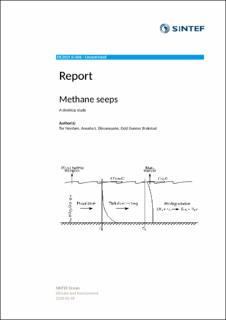| dc.description.abstract | We have conducted a literature review and a simplified one-dimensional modelling study on the fate of methane bubbles and dissolved methane in the water column originating from methane seeps. From the literature review, we have found that the physical processes describing the rise and dissolution of methane bubbles are relatively well understood, and several studies use very similar modelling approaches. When it comes to biodegradation rates for dissolved methane in seawater, there is far more uncertainty, and published values span a range of six orders of magnitude. These rates may also depend on local conditions, and on methane concentrations, as higher concentrations allow methane-degrading bacteria to exist in larger numbers. On the topic of how methane seeps contribute to the acidification of the ocean, we find that the amounts of methane released from seeps are probably too small to make a significant difference, compared to other sources of CO2, such as the dissolution of atmospheric CO2 into the ocean. Modelling of seeps at three different depths (50 m, 120 m and 300 m) indicates that almost all of the methane released as bubbles will dissolve into the water column before the bubbles reach the surface. For the dissolved methane, we have used the diffusion-reaction equation to investigate how much biodegrades, and how much is released to the atmosphere via mass transfer across the sea surface. To reflect the uncertainty in published biodegradation rates, we conducted a parameter study, running simulations for biodegradation half-lives ranging from 10 to 1000 days. The model results indicate that for methane seeps at 50 m depth most of the methane will reach the atmosphere, for seeps at 120 m depth, more than half the methane will reach the atmosphere if the biodegradation half-life is longer than about 50 days, and for seeps at 300 m depth, more than half of the methane will reach the atmosphere if the half-life is longer than about 300 days. In these studies, we have assumed a relatively well-mixed water column during the winter season. | en_US |

